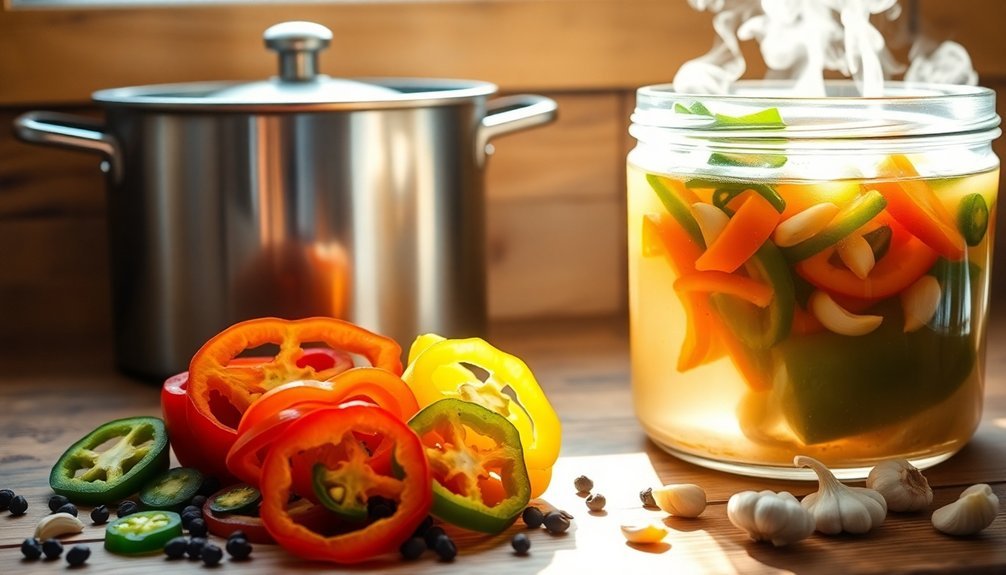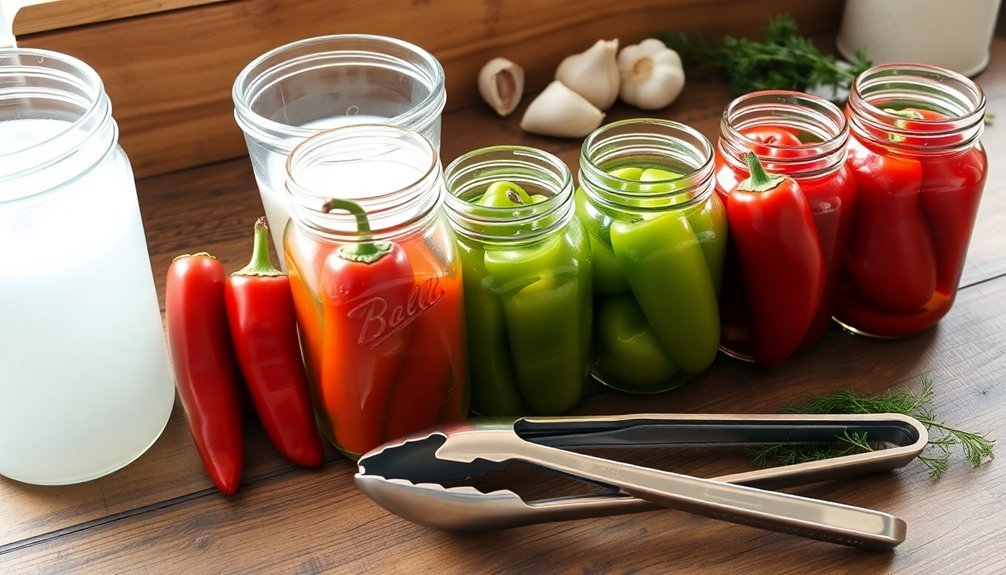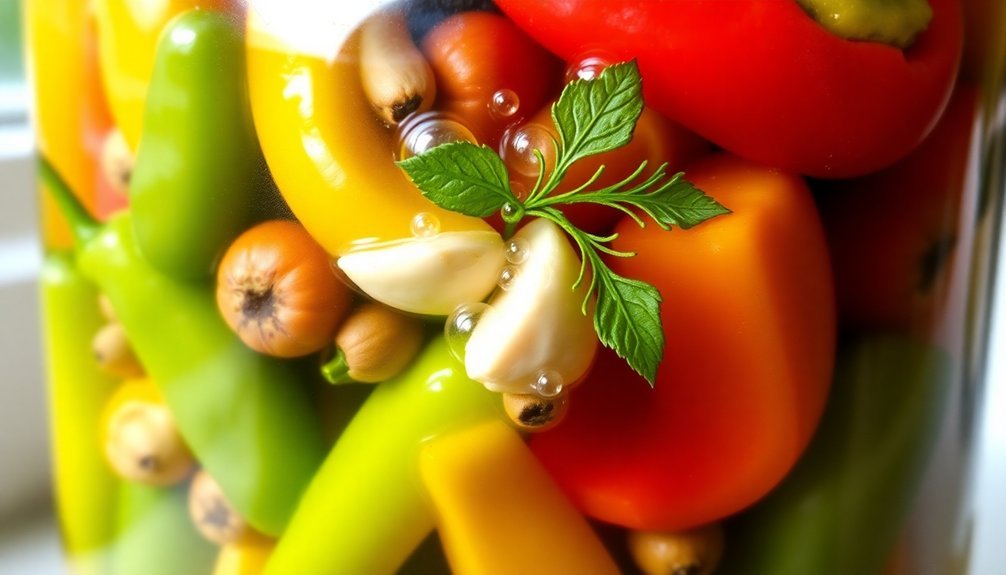You've got three reliable ways to pickle those peppers today. The quickest method is refrigerator pickling – just slice your peppers, make a vinegar brine, and store them in the fridge for up to 4 months. For longer storage, try hot water bath canning, which requires specific equipment but keeps your peppers shelf-stable for over a year. The cold pack vinegar process offers a middle ground, using a simple vinegar solution without extensive water boiling. Each method delivers crisp, tangy results, and the techniques below will help you master your preferred preservation style.
Quick Refrigerator Pickle Method

Many home cooks favor the quick refrigerator pickle method because it's simple, fast, and doesn't require traditional canning equipment.
You'll start by slicing your chosen peppers into thin rings – whether you're using sweet mini peppers, jalapeños, or bell peppers. Add complementary ingredients like sliced shallots, onions, and garlic to enhance the flavor profile.
To create your pickling liquid, combine your choice of vinegar (white wine, apple cider, or distilled white) with water, salt, and sugar or honey in a saucepan. Bring this mixture to a boil, adding dried oregano, dill, mustard seeds, or black peppercorns for extra flavor. You can also include red pepper flakes if you want a spicier result.
Pack your sliced peppers and additional ingredients into clean jars, leaving some headspace at the top. Pour the hot brine over the peppers until they're completely submerged. The entire preparation process typically takes about 20 minutes total.
Once you've sealed the jars (they don't need to be airtight), let them cool at room temperature before refrigerating. Your pickled peppers will be ready to enjoy within a few hours to days and will keep in the refrigerator for up to four months.
Hot Water Bath Canning
Hot water bath canning offers a reliable method for long-term pepper preservation without refrigeration. To begin, you'll need to gather proper equipment, including canning jars with new lids, a large water bath canner with rack, jar lifter, funnel, and bubble freer. Confirm all your jars and lids are clean and free from defects.
Start by washing your peppers and cutting them into uniform pieces, or leave them whole with small slits to prevent bursting. Don't forget to wear gloves while handling the peppers to protect your skin. For optimal results, discard any wilted or damaged peppers before processing.
Next, prepare your brine by combining water, vinegar (5% acidity), and canning salt in a large pot. You can add optional seasonings like garlic, celery seed, or mustard seed for extra flavor.
Pack your peppers tightly into hot, clean jars and pour the boiling brine over them, leaving ½ inch headspace. After removing air bubbles, place the jars in your water bath canner, confirming they're covered by 1-2 inches of water.
Process for at least 10 minutes at a full boil, then let them rest for 5 minutes before removing. Check the seals after 12-24 hours before storing in a cool, dark place.
Cold Pack Vinegar Process

While hot water bath canning offers a traditional preservation method, the cold pack vinegar process provides a simpler alternative that doesn't require heating large quantities of water.
You'll need to start by washing your peppers thoroughly and removing any damaged ones. For small peppers, keep them whole but make small slits to allow the vinegar to penetrate. If you're using larger peppers, core them and cut them into strips. Five pounds of assorted peppers works perfectly for this recipe.
Before packing your peppers, you'll need to sterilize your jars. Submerge them in boiling water for 10 minutes, along with the lids and screwbands. Remove each jar carefully and drain it before packing your peppers tightly inside.
For the vinegar solution, you'll want to use high-grade vinegar with at least 5% acidity. Mix it with water in a 2:1 ratio (one cup vinegar to half cup water).
Pour this solution over your packed peppers until they're completely covered. Once you've sealed the jars with sterilized lids and screwbands, store them in a cool, dark place.
You'll need to wait at least one month before enjoying your pickled peppers, but they'll last for years when properly stored.
Frequently Asked Questions
Can Pickled Peppers Be Frozen for Long-Term Storage?
You shouldn't freeze pickled peppers, as they'll lose their crisp texture and flavor quality. Instead, store them in the refrigerator for up to 6 months or use water-bath canning for long-term preservation.
How Do You Revive Peppers That Have Become Too Soft?
You can revive soft peppers by soaking sliced pieces in cold water or an ice bath for an hour. If that doesn't work, try roasting them at 450°F or pickling them to extend their usability.
Why Do Some Pickled Peppers Float to the Top?
Your pickled peppers float because they're less dense than the brine and contain trapped air pockets. If you haven't pre-cooked or properly sliced them, they'll naturally rise to the top of your jar.
What Causes Pickled Peppers to Become Cloudy in the Jar?
Your pickled peppers can become cloudy due to natural fermentation, hard water, or using table salt with anti-caking agents. It's usually harmless – the cloudiness means beneficial bacteria are doing their preservation work.
Can Leftover Pickling Brine Be Reused for a New Batch?
You can reuse leftover pickling brine for refrigerator pickles, but don't use it for canning. Just boil it first, check for clarity, and add fresh vinegar. Use within 2-4 weeks for best results.
In Summary
You've now learned three reliable methods for preserving your pepper harvest. Whether you've chosen the quick refrigerator pickle technique, traditional hot water bath canning, or the cold pack vinegar process, you'll enjoy homemade pickled peppers year-round. Start with small batches until you're comfortable with each method, and don't forget to label your jars with the date. Soon you'll be pickling peppers like a pro.





Leave a Reply